Podcast: Play in new window | Download
Subscribe: Apple Podcasts | RSS
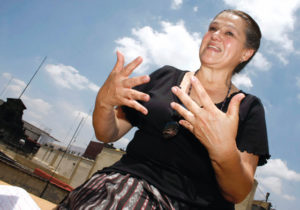 Digging 3 meters down from the floor of the National Museum of Cultures in Mexico City, the archaeological team headed by Doctor Elsa Cristina Hernández Pons hit a curious basalt slab. Ever since Hernández was a little girl she had been lucky at finding things. On trips to the sprawling ruins of the ancient city of Teotihuacán in the early 1960s, accompanied by her father, she would find pieces of obsidian and fragments of pottery for her collection while digging just below the surface. She would nurture her curiosity of the past and later studied to become an archaeologist, earning her PhD from the National Autonomous University of Mexico, or UNAM. After her dissertation, Hernández was hired by Mexico’s National Institute of Anthropology and History in July of 1978 to work at the site of the Templo Mayor, the main ancient pyramid complex, in the heart of Mexico City. Over the course of her career she has had some amazing finds, including the discovery of a 500-year-old Aztec sculpture called “The Cuauhxicalli Eagle” in 1985, an intact stone carving of a gigantic bird that was so detailed one could see the fine lines of the feathers on its back. Her latest discovery in 2015 may be her most important find yet. Like so many other buildings in the older part of Mexico City, the National Museum of Culture was built on top of a building that was once another building. Hernández’ excavation is like a time tunnel going all the way to the epoch when Mexico City was the imperial capital of the vast Aztec Empire and was then called Tenochtitlán. The basalt floor she found is not to any ordinary building. Archaeologists believe that Doctor Hernández has found the section of the imperial palace of the Aztec emperors called Las Casas Nuevas, which would be loosely translated into “the newer additions” in English. These newer additions to the palace complex were made by Emperor Montezuma the Second, the 45-year-old ruler of the Aztecs who lorded over the Aztec Empire at the time of the Spanish Conquest led by Hernán
Digging 3 meters down from the floor of the National Museum of Cultures in Mexico City, the archaeological team headed by Doctor Elsa Cristina Hernández Pons hit a curious basalt slab. Ever since Hernández was a little girl she had been lucky at finding things. On trips to the sprawling ruins of the ancient city of Teotihuacán in the early 1960s, accompanied by her father, she would find pieces of obsidian and fragments of pottery for her collection while digging just below the surface. She would nurture her curiosity of the past and later studied to become an archaeologist, earning her PhD from the National Autonomous University of Mexico, or UNAM. After her dissertation, Hernández was hired by Mexico’s National Institute of Anthropology and History in July of 1978 to work at the site of the Templo Mayor, the main ancient pyramid complex, in the heart of Mexico City. Over the course of her career she has had some amazing finds, including the discovery of a 500-year-old Aztec sculpture called “The Cuauhxicalli Eagle” in 1985, an intact stone carving of a gigantic bird that was so detailed one could see the fine lines of the feathers on its back. Her latest discovery in 2015 may be her most important find yet. Like so many other buildings in the older part of Mexico City, the National Museum of Culture was built on top of a building that was once another building. Hernández’ excavation is like a time tunnel going all the way to the epoch when Mexico City was the imperial capital of the vast Aztec Empire and was then called Tenochtitlán. The basalt floor she found is not to any ordinary building. Archaeologists believe that Doctor Hernández has found the section of the imperial palace of the Aztec emperors called Las Casas Nuevas, which would be loosely translated into “the newer additions” in English. These newer additions to the palace complex were made by Emperor Montezuma the Second, the 45-year-old ruler of the Aztecs who lorded over the Aztec Empire at the time of the Spanish Conquest led by Hernán 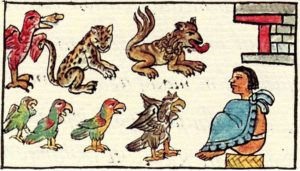 Cortés in 1519. According to Spanish written accounts from the time, in the newer part of the palace complex we find Montezuma’s meditation rooms as well as the emperor’s legendary zoo, a private menagerie that would have been the envy of any European ruler at the time and may have been much larger than the fabulous zoo of the Great Khan as described by Italian adventurer Marco Polo on his visit to China in the 13th Century. Work continues beneath the culture museum and the possible find of Montezuma’s zoo may be the crowning achievement of the career of Doctor Hernández which has solidly spanned 4 decades.
Cortés in 1519. According to Spanish written accounts from the time, in the newer part of the palace complex we find Montezuma’s meditation rooms as well as the emperor’s legendary zoo, a private menagerie that would have been the envy of any European ruler at the time and may have been much larger than the fabulous zoo of the Great Khan as described by Italian adventurer Marco Polo on his visit to China in the 13th Century. Work continues beneath the culture museum and the possible find of Montezuma’s zoo may be the crowning achievement of the career of Doctor Hernández which has solidly spanned 4 decades.
Before we talk about the emperor’s menagerie, we must first provide context. At the time of the Spanish arrival in Mexico, the Aztecs were the rulers of the majority of the lands and peoples of the central part of the country. The Aztecs ruled over people directly or through small client kingdoms which paid the empire tribute. A vast trade network radiated outward from the capital of Tenochtitlán, 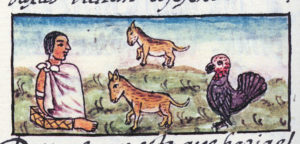 which was built on an island in the middle of Lake Texcoco and later became the modern-day capital called Mexico City. The trade network penetrated the dense jungles of Central America and extended as far north as the Indian villages in present-day Arizona and New Mexico. Tenochtitlán was the center of what has been termed as a dendritic system; all roads eventually led back to the capital with a positive flow of wealth coming to Tenochtitlán as the center of empire. When the Spanish arrived here in 1519 they were not met with hostility. The emperor knew Cortés was coming, and curious about the Spaniard’s intentions, he welcomed the visitor and his men as honored guests. Because of this cordial reception we have many first-hand European accounts of a living and breathing Aztec Empire. All of Cortés’ contingent were amazed at the city. Many of the Spanish soldiers had visited the major metropolises of the Old World: Jerusalem, Rome, Constantinople. Nothing prepared them for the magnificence they would experience once they crossed the narrow causeway spanning the lake and were welcomed to Tenochtitlán by Montezuma. The majestic buildings, the abundance and efficiency of the markets, the cleanliness and attention to detail throughout the capital city were unlike anything they had ever before seen on earth. The massive imperial palace complex drew much attention. There were swimming pools, lavish apartments for the emperor’s family and foreign dignitaries, lush gardens where thousands of flowers bloomed and the often-wrote-about legendary private zoo of Montezuma.
which was built on an island in the middle of Lake Texcoco and later became the modern-day capital called Mexico City. The trade network penetrated the dense jungles of Central America and extended as far north as the Indian villages in present-day Arizona and New Mexico. Tenochtitlán was the center of what has been termed as a dendritic system; all roads eventually led back to the capital with a positive flow of wealth coming to Tenochtitlán as the center of empire. When the Spanish arrived here in 1519 they were not met with hostility. The emperor knew Cortés was coming, and curious about the Spaniard’s intentions, he welcomed the visitor and his men as honored guests. Because of this cordial reception we have many first-hand European accounts of a living and breathing Aztec Empire. All of Cortés’ contingent were amazed at the city. Many of the Spanish soldiers had visited the major metropolises of the Old World: Jerusalem, Rome, Constantinople. Nothing prepared them for the magnificence they would experience once they crossed the narrow causeway spanning the lake and were welcomed to Tenochtitlán by Montezuma. The majestic buildings, the abundance and efficiency of the markets, the cleanliness and attention to detail throughout the capital city were unlike anything they had ever before seen on earth. The massive imperial palace complex drew much attention. There were swimming pools, lavish apartments for the emperor’s family and foreign dignitaries, lush gardens where thousands of flowers bloomed and the often-wrote-about legendary private zoo of Montezuma.
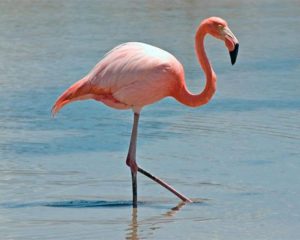 The zoo consisted of two aviaries, one for larger birds of prey and one for smaller birds. There were 20 ponds – 10 of freshwater and 10 of saltwater – which were stocked with various fish and served as habitat for waterfowl. There was a section for mammals, including large carnivores, and one for reptiles. As they were unfamiliar with the names of the many animals, the Spanish could only briefly describe what they saw in their journals and other written accounts. A member of the Cortés expedition named Bernal Díaz del Castillo writes this about the aviaries in his book, Historia verdadera de la conquista de la Nueva España, The True History of the Conquest of New Spain:
The zoo consisted of two aviaries, one for larger birds of prey and one for smaller birds. There were 20 ponds – 10 of freshwater and 10 of saltwater – which were stocked with various fish and served as habitat for waterfowl. There was a section for mammals, including large carnivores, and one for reptiles. As they were unfamiliar with the names of the many animals, the Spanish could only briefly describe what they saw in their journals and other written accounts. A member of the Cortés expedition named Bernal Díaz del Castillo writes this about the aviaries in his book, Historia verdadera de la conquista de la Nueva España, The True History of the Conquest of New Spain:
“I am forced to abstain from enumerating every kind of bird that was there and it peculiarity, for there was everything from the Royal Eagle and other smaller eagles, and many other birds of great size, down to tiny birds of many-colored plumage, also the birds from which they take the rich plumage which they use in their green feather work. They birds which have these feathers are about the size of the magpies of Spain, they are called in this country quetzales and there are other birds which have feathers of five colors – green, red, white, yellow and blue; I don’t remember what they are called; then there were parrots of many different colors, and there are so many of them that I forget their names, not to mention the beautifully marked ducks and other larger ones like them. From all these birds they plucked the feathers when the time was right to do so, and the feathers grew again. All the birds that I have spoken about breed in these houses, and in the setting season certain Indian men and women who look after the birds place the eggs under them and clean the nests and feed them, so that each kind of bird has its proper food. In this house that I have spoken of there is a great tank of fresh water and in it there are sorts of birds with long stilted legs, with body, wings and tail all red; I don’t know their names, but in the island of Cuba they are called Ypiris, and there are others something like them, and there are also in that tank many other kinds of birds which always live in water.”
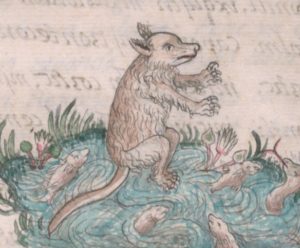 The zoo had thousands of specimens and the Spaniards noted that it employed over 300 zookeepers to tend to the animals. As turkeys were an abundant source of food in the Aztec Empire, chroniclers wrote that 500 turkeys a day were used as food for the carnivorous animals, which not only included the birds of prey but also included wolves, large dogs and the great cats such as jaguars and pumas. These animals also, it was noted, fed on the remains of human captors or sacrificial victims, which were many.
The zoo had thousands of specimens and the Spaniards noted that it employed over 300 zookeepers to tend to the animals. As turkeys were an abundant source of food in the Aztec Empire, chroniclers wrote that 500 turkeys a day were used as food for the carnivorous animals, which not only included the birds of prey but also included wolves, large dogs and the great cats such as jaguars and pumas. These animals also, it was noted, fed on the remains of human captors or sacrificial victims, which were many.
While writing of the mammalian part of the zoo which included sloths, monkeys, bears, rodents and canines of all kinds, Bernal Díaz recounts the most curious area of the zoo to the Spanish visitors, the reptile house, filled with alligators, lizards and snakes of all kinds. He says:
“They also have in that cursed house many vipers and poisonous snakes which carry on their tails things that sound like bells. These are the worst vipers of all, and they keep them in jars and great pottery vessels with many feathers, and there they lay their eggs and rear their young, and they give them to eat the bodies of the Indians who have been  sacrificed, and the flesh of the tiny dogs which they are in the habit of breeding.”
sacrificed, and the flesh of the tiny dogs which they are in the habit of breeding.”
Díaz concludes his account of the zoo by writing the following:
“Let me speak now of the infernal noise when the lions and tigers roared and the jackals and foxes howled and the serpents hissed. It was horrible to listen to and it seemed like hell.”
Montezuma’s zoo had a section not seen in any modern zoo: an area for human curiosities. Dwarves and people with various deformities and disabilities who hailed from all parts of the empire were housed in the zoo. As these people were separated from their families, the State compensated family members generously, taking care of them for life. It was almost seen as a blessing to have a relative living in the imperial palace’s human zoo.
To the Spanish, the most unbelievable animal at the zoo was called “The Mexican Bull.” A member of the Cortés expedition named Solís described the animal thus:
“It has crooked shoulders, with a bunch on its back like a camel; its flanks dry, its tail large, and its neck covered with hair like a lion. It is cloven footed, its head armed like that of a bull, which it resembles in fierceness, with no less strength and agility.”
Solís was describing a familiar sight to those Natives of the North American Great Plains. The Mexican Bull was really and American bison, more commonly known as a buffalo. At the time of the Aztec Empire’s height, North American bison were found over a thousand miles from the capital city. There were small herds that roamed the northern scrub prairie areas of the modern-day Mexican states of Durango and Nuevo Leon. One could only imagine how an animal like that was transported all the way to Montezuma’s zoo, given that the Aztecs had no use of the wheel.
 And what became of Montezuma’s zoo? The story has a tragic ending. When the “honeymoon period” between Cortés and Emperor Montezuma ended, the Spanish decided to take over the Aztec capital and laid siege to the city. The siege lasted 75 days during which the capital which had a population of over a quarter million people was cut off from the mainland and was subjugated through mass starvation. During the two and a half months of the siege, the inhabitants of the once-mighty capital became desperate for food. By the time the population was completely demoralized and surrendered to the Spanish, all animals in the emperor’s private menagerie had been eaten and the grand zoo of Montezuma became the stuff of legend.
And what became of Montezuma’s zoo? The story has a tragic ending. When the “honeymoon period” between Cortés and Emperor Montezuma ended, the Spanish decided to take over the Aztec capital and laid siege to the city. The siege lasted 75 days during which the capital which had a population of over a quarter million people was cut off from the mainland and was subjugated through mass starvation. During the two and a half months of the siege, the inhabitants of the once-mighty capital became desperate for food. By the time the population was completely demoralized and surrendered to the Spanish, all animals in the emperor’s private menagerie had been eaten and the grand zoo of Montezuma became the stuff of legend.
REFERENCES (This is not a formal bibliography)
Conquest of Mexico by William H. Prescott
The Discovery and Conquest of Mexico by Bernal Díaz del Castillo
Aztecs of Mexico: Origin, Rise and Fall of the Aztec Nation by George C. Vaillant
